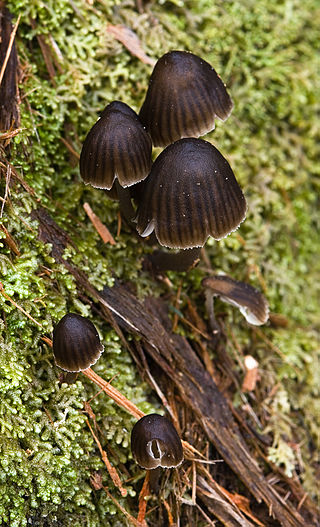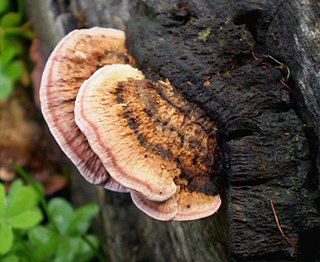
The Polyporales are an order of about 1800 species of fungi in the division Basidiomycota. The order includes some polypores as well as many corticioid fungi and a few agarics. Many species within the order are saprotrophic, most of them wood-rotters. Some genera, such as Ganoderma and Fomes, contain species that attack living tissues and then continue to degrade the wood of their dead hosts. Those of economic importance include several important pathogens of trees and a few species that cause damage by rotting structural timber. Some of the Polyporales are commercially cultivated and marketed for use as food items or in traditional Chinese medicine.

Polypores are a group of fungi that form large fruiting bodies with pores or tubes on the underside. They are a morphological group of basidiomycetes-like gilled mushrooms and hydnoid fungi, and not all polypores are closely related to each other. Polypores are also called bracket fungi or shelf fungi, and they characteristically produce woody, shelf- or bracket-shaped or occasionally circular fruiting bodies that are called conks.

Trametes versicolor – also known as Coriolus versicolor and Polyporus versicolor – is a common polypore mushroom found throughout the world. Meaning 'of several colors', versicolor accurately describes this fungus that displays a unique blend of markings. Additionally, owing to its shape being similar to that of a wild turkey's tail feathers, T. versicolor is most commonly referred to as turkey tail. A similar-looking mushroom commonly called "false turkey tail" is from a different order (Stereum), and thus may sometimes be confused with the 'true' turkey tail mushroom, T. versicolor. Another lookalike is the multicolor gill polypore, T. betulina.

A wood-decay or xylophagous fungus is any species of fungus that digests moist wood, causing it to rot. Some species of wood-decay fungi attack dead wood, such as brown rot, and some, such as Armillaria, are parasitic and colonize living trees. Excessive moisture above the fibre saturation point in wood is required for fungal colonization and proliferation. In nature, this process causes the breakdown of complex molecules and leads to the return of nutrients to the soil. Wood-decay fungi consume wood in various ways; for example, some attack the carbohydrates in wood, and some others decay lignin. The rate of decay of wooden materials in various climates can be estimated by empirical models.

Irpex lacteus is a common crust fungus distributed throughout temperate areas of the world. It is the type of the genus Irpex. Irpex lacteus is considered a polypore, but depending on growth conditions it can also produce a hydnoid hymenophore. Due to this variability and abundance of the species it has been described as a new species to science numerous times and subsequently has an extensive synonymy. The complete genome sequence of Irpex lacteus was reported in 2017.

Gloeophyllum sepiarium, the rusty gilled polypore, is a wood decay fungus that causes a brown rot. Gloeophyllum sepiarium grows in thin, dark brown/green brackets on dead conifers. Often found on wood in lumberyards, the fruiting body grows for only one year, and produces spores in late summer and autumn. Its hymenial surface is distinctive from other polypores due to the presence of gills. Gloeophyllum sepiarium is inedible.

Bjerkandera adusta, commonly known as the smoky polypore or smoky bracket, is a species of fungus in the family Meruliaceae. It is a plant pathogen that causes white rot in live trees, but most commonly appears on dead wood. It was first described scientifically as Boletus adustus by Carl Ludwig Willdenow in 1787. The genome sequence of Bjerkandera adusta was reported in 2013. The species is inedible.

Cerrena unicolor, commonly known as the mossy maze polypore, is a species of poroid fungus in the genus Cerrena. This saprobic fungus causes white rot.

Trametes elegans, also known as Lenzites elegans and Daedalea elegans, is a common polypore and wood-decay fungus with a pantropical distribution found on hardwood hosts in regions including Australia, New Zealand, and Japan. It has recently been suggested to be a complex of three different species: T. elegans,T. aesculi, and T. repanda.

Spalting is any form of wood coloration caused by fungi. Although primarily found in dead trees, spalting can also occur in living trees under stress. Although spalting can cause weight loss and strength loss in the wood, the unique coloration and patterns of spalted wood are sought by woodworkers.

Trametes is a genus of fungi that is distinguished by a pileate basidiocarp, di- to trimitic hyphal systems, smooth non-dextrinoid spores, and a hymenium usually without true hymenial cystidia. The genus has a widespread distribution and contains about 195 species. The genus was circumscribed by Elias Magnus Fries in 1836.

Trametes gibbosa, commonly known as the lumpy bracket, is a polypore mushroom that causes white rot. It is found on beech stumps and the dead wood of other hardwood species. Fruit bodies are 8–15 cm in diameter and semicircular in shape. The upper surface is usually gray or white, but may be greenish in older specimens due to algal growth. Elongated pores are located on the under-surface. The fruiting bodies are frequently attacked by boring beetle larvae.

Daedalea quercina is a species of mushroom in the order Polyporales, and the type species of the genus Daedalea. Commonly known as the thick-walled maze polypore, maze-gill fungusoak-loving maze polypore, or oak mazegill, the specific epithet refers to the oak genus Quercus, upon which it frequently grows, causing a brown rot. It is found in Europe, Asia, Northern Africa and Australasia. Though inedible, it can be used as a natural comb and has been the subject of chemical research.

Ascocoryne sarcoides is a species of fungus in the family Helotiaceae. The species name is derived from the Greek sarkodes (fleshy). Formerly known as Coryne sarcoides, its taxonomical history has been complicated by the fact that it may adopt both sexual and asexual forms. Colloquially known as jelly drops or the purple jellydisc, this common fungus appears as a gelatinous mass of pinkish or purple-colored discs. Distributed widely in North America, Eurasia, and Oceania, A. sarcoides is a saprobic fungus and grows in clusters on the trunks and branches of a variety of dead woods. Field studies suggest that colonization by A. sarcoides of the heartwood of black spruce confers some resistance to further infection by rot-causing fungi. A. sarcoides contains the antibiotic compound ascocorynin, shown in the laboratory to inhibit the growth of several gram-positive bacteria.

Mycena nargan, commonly known as the Nargan's bonnet, is a species of fungus in the family Mycenaceae, and the sole member of the section Nargan in the genus Mycena. Reported as a new species in 1995, it is known predominantly from Southern Australia. The saprobic fungus produces mushrooms that grow on well-decayed wood, often on the underside of wood lying in litter. The dark chestnut-coloured caps are covered with white, easily removed scales, and reach diameters of up to 2 cm (0.8 in) wide. The pale, slender stems are up to 5 cm (2.0 in) long and have white scales at the base. On the underside of the cap, the cream-coloured gills are widely spaced and bluntly attached to the stem. The edibility of the mushroom is unknown.

Lenzites warnieri is a species of fungus in the family Polyporaceae found in parts of Europe, Asia, and northern Africa. The species is a white rot pathogen on living wood. Its corky fruiting bodies in the shape of semicircular plates form on the trunks of several types of deciduous trees growing near water bodies in regions of moist sub-Mediterranean climate. The fruiting body, which has a lamellar fruit layer, produces spores only once.

Xylobolus frustulatus, commonly known as the ceramic fungus or ceramic parchment, is an inedible species of crust fungus in the Stereaceae family. The fruit body forms small, hard, flat crust-like aggregations that resemble broken pieces of ceramic tile. These pieces are initially whitish before turning yellow-brown to gray-brown in age. The spore-bearing cells cover the upper surfaces of the fruit body. A saprobic species, it grows on well-decayed oak wood in Asia, northern Europe, and North America.

Tubaria punicea is a rare species of agaric fungus in the family Tubariaceae. It is found on the west coast of North America, where it grows on the bases and in hollows of madrone.

Oudemansiella mucida, commonly known as porcelain fungus, is a basidiomycete fungus of the family Physalacriaceae and native to Europe.

Rhodofomitopsis lilacinogilva is a species of bracket fungus in the family Fomitopsidaceae. Known primarily from Australia, it has also been recorded from Brazil and India. It is a white-rot fungus that grows on rotting eucalyptus wood. Its main identifying feature is the lilac colour of the pore surface on the underside of the fruit body.



















